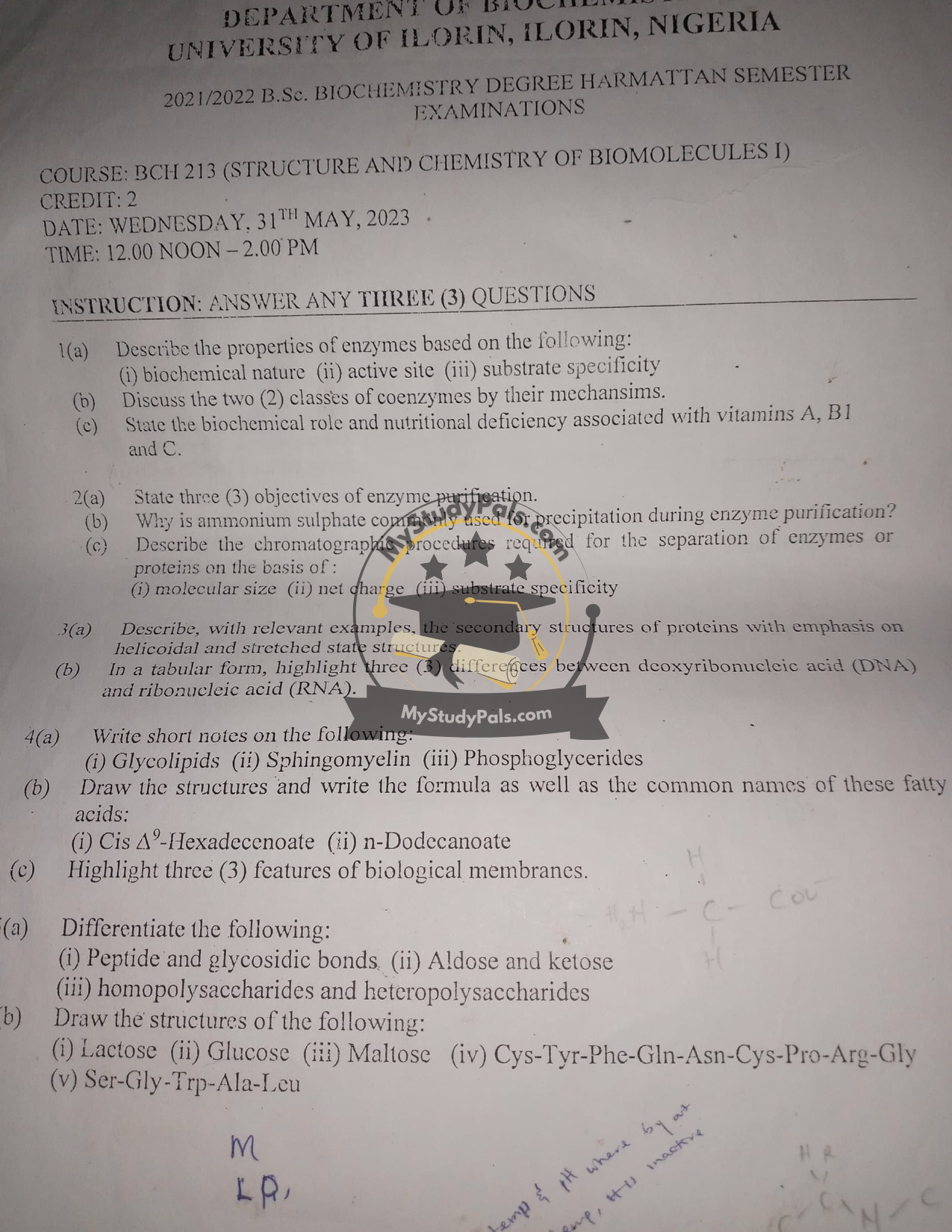ANWSER
Question 1:
(a) Describe the properties of enzymes based on the following:
- Biochemical nature: Enzymes are biological macromolecules, mostly proteins (with some RNA enzymes known as ribozymes), that catalyze biochemical reactions by lowering the activation energy required.
- Active site: The active site is a specific region on the enzyme where substrate binding occurs, leading to catalysis. It has a unique shape that complements the substrate, ensuring specificity.
- Substrate specificity: Enzymes exhibit high specificity, meaning they act on specific substrates based on shape, charge, and functional groups. This specificity is often described by the lock-and-key or induced fit model.
(b) Discuss the two (2) classes of coenzymes by their mechanisms.
- Cosubstrates: These are loosely bound coenzymes that temporarily associate with the enzyme and are altered in the reaction before being released. Examples include NAD⁺ and Coenzyme A.
- Prosthetic groups: These are tightly bound coenzymes that remain permanently attached to the enzyme, often via covalent bonds. Examples include FAD and biotin.
(c) State the biochemical role and nutritional deficiency associated with vitamins A, B1, and C.
- Vitamin A: Functions in vision (as retinal in rhodopsin), immune function, and cell growth. Deficiency causes night blindness and xerophthalmia.
- Vitamin B1 (Thiamine): Essential for carbohydrate metabolism (as TPP in pyruvate dehydrogenase). Deficiency leads to beriberi and Wernicke-Korsakoff syndrome.
- Vitamin C (Ascorbic Acid): Acts as an antioxidant and coenzyme in collagen synthesis. Deficiency results in scurvy, characterized by bleeding gums and impaired wound healing.
Question 2:
(a) State three (3) objectives of enzyme purification.
- To obtain enzymes in a pure form for structural and functional studies.
- To eliminate contaminants that may interfere with enzymatic activity assays.
- To produce enzymes for industrial, pharmaceutical, or research applications.
(b) Why is ammonium sulfate commonly used for precipitation during enzyme purification?
- Ammonium sulfate is used due to its ability to salt out proteins by reducing their solubility, thereby promoting precipitation. It stabilizes enzymes and minimizes proteolytic degradation during purification.
(c) Describe the chromatographic procedures required for the separation of enzymes or proteins on the basis of:
- Molecular size: Size-exclusion chromatography (gel filtration) separates proteins based on size, with larger molecules eluting first.
- Net charge: Ion-exchange chromatography separates proteins based on charge interactions with a charged stationary phase.
- Substrate specificity: Affinity chromatography utilizes a specific ligand bound to a matrix to selectively bind target enzymes, which are later eluted.
Question 3:
(a) Describe, with relevant examples, the secondary structures of proteins with emphasis on helicoidal and stretched state structures.
- Helicoidal structure (α-helix): A right-handed coil stabilized by hydrogen bonding between the carbonyl oxygen and amide hydrogen (e.g., myoglobin and hemoglobin).
- Stretched state structure (β-sheet): A pleated sheet arrangement where polypeptide chains align laterally and form hydrogen bonds (e.g., silk fibroin).
(b) In a tabular form, highlight three (3) differences between deoxyribonucleic acid (DNA) and ribonucleic acid (RNA).
| Feature | DNA | RNA |
|---|---|---|
| Sugar | Deoxyribose | Ribose |
| Bases | A, T, G, C | A, U, G, C |
| Structure | Double-stranded | Single-stranded |
Question 4:
(a) Write short notes on the following:
- Glycolipids: Lipids with carbohydrate groups, essential for cell recognition and signaling (e.g., gangliosides).
- Sphingomyelin: A sphingolipid with a phosphocholine head, a major component of myelin sheaths in nerve cells.
- Phosphoglycerides: Glycerol-based phospholipids that form the structural basis of biological membranes (e.g., phosphatidylcholine).
(b) Draw the structures and write the formula as well as the common names of these fatty acids:
- Cis Δ⁹-Hexadecenoate: (C₁₆H₃₀O₂) – Common name: Palmitoleic acid.
- n-Dodecanoate: (C₁₂H₂₄O₂) – Common name: Lauric acid.
(c) Highlight three (3) features of biological membranes.
- Fluidity: Lipids and proteins can move within the bilayer.
- Selectivity: Membranes control substance passage via selective permeability.
- Asymmetry: Inner and outer leaflets have different lipid and protein compositions.
Question 5:
(a) Differentiate the following:
- Peptide and glycosidic bonds:
- Peptide bond: Covalent bond between amino acids (amide linkage).
- Glycosidic bond: Covalent bond between carbohydrate molecules (ether linkage).
- Aldose and ketose:
- Aldose: A sugar with an aldehyde group (e.g., glucose).
- Ketose: A sugar with a ketone group (e.g., fructose).
- Homopolysaccharides and heteropolysaccharides:
- Homopolysaccharides: Polysaccharides made of one type of monosaccharide (e.g., starch, cellulose).
- Heteropolysaccharides: Polysaccharides composed of different monosaccharide units (e.g., hyaluronic acid).
(b) Draw the structures of the following:
- Lactose
- Glucose
- Maltose
- Cys-Tyr-Phe-Gln-Asn-Cys-Pro-Arg-Gly
- Ser-Gly-Trp-Ala-Ileu
(For part (b), drawing is required.


